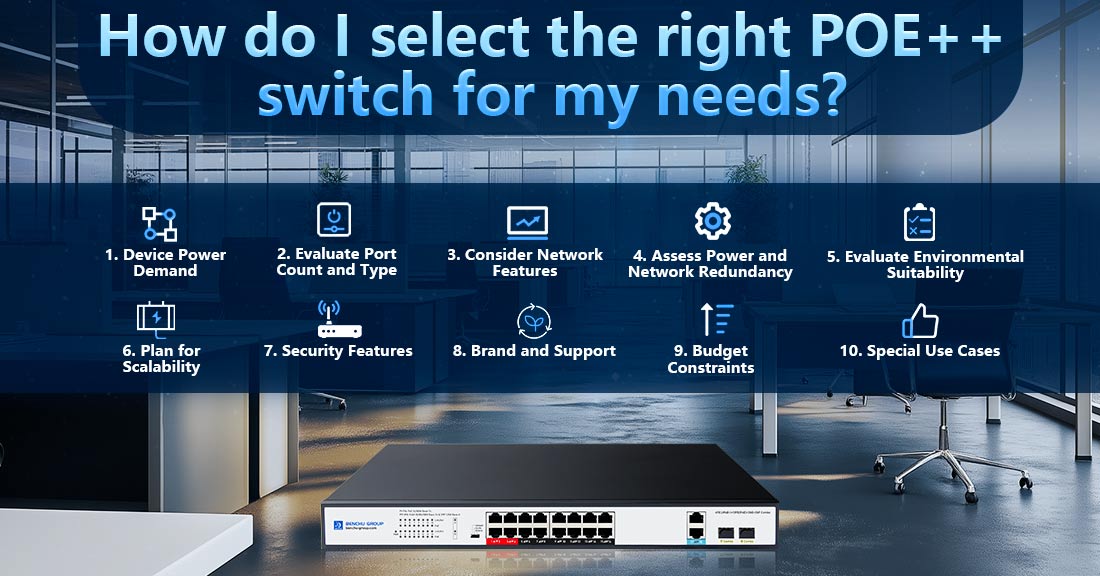
Pour sélectionner le bon commutateur PoE++, vous devez évaluer vos besoins spécifiques, notamment les besoins en énergie, la taille du réseau, la compatibilité des appareils et l'évolutivité future. Les commutateurs PoE++, qui adhèrent à la norme IEEE 802.3bt, sont capables de fournir jusqu'à 100 W par port, ce qui les rend idéaux pour les appareils haute puissance. Pour garantir le meilleur choix adapté à vos besoins, tenez compte des facteurs suivants :
1. Déterminez les besoins en énergie des appareils connectés
Demande de puissance de l'appareil :
--- Identifiez les besoins en énergie des appareils à connecter (par exemple, caméras IP, points d'accès sans fil, éclairage LED ou appareils intelligents).
Besoins typiques en alimentation de l'appareil :
--- PoE (IEEE 802.3af) : jusqu'à 15,4 W
--- PoE+ (IEEE 802.3at) : jusqu'à 30 W
--- PoE++ (IEEE 802.3bt) : jusqu'à 60 W (Type 3) ou 100 W (Type 4)
Budget de puissance :
Calculez le budget énergétique total requis en additionnant les besoins électriques de tous les appareils. Par exemple, si vous avez :
--- 5 appareils nécessitant 30W chacun = 150W au total.
--- 2 appareils nécessitant 90W chacun = 180W au total.
Choisissez un commutateur avec un budget de puissance total supérieur à vos besoins pour éviter les surcharges.
2. Évaluer le nombre et le type de ports
Nombre de ports :
--- Faites correspondre le nombre de ports PoE++ sur le commutateur au nombre d'appareils que vous prévoyez de connecter.
--- Petits réseaux : 4 à 8 ports.
--- Réseaux moyens à grands : 16, 24 ou 48 ports.
Ports de liaison montante :
--- Assurez-vous que le commutateur comprend des ports de liaison montante (par exemple, SFP ou SFP+ pour les connexions fibre) si vous avez besoin de connexions haut débit à un commutateur principal ou à d'autres segments de réseau.
Vitesse portuaire :
--- Vérifiez que le commutateur prend en charge une vitesse suffisante pour vos appareils, telle que Gigabit Ethernet pour la plupart des applications ou 10 Gigabit Ethernet pour les besoins de hautes performances.
3. Tenez compte des fonctionnalités du réseau
Commutateurs gérés et non gérés :
Commutateurs gérés :
--- Vous permet de configurer et de surveiller votre réseau.
--- Fournit des fonctionnalités avancées telles que les VLAN, la qualité de service (QoS) et le contrôle de la bande passante.
--- Idéal pour les configurations complexes avec plusieurs appareils.
Commutateurs non gérés :
--- Fonctionnement Plug-and-play sans configuration requise.
--- Idéal pour les petits réseaux simples.
Couche 2 ou Couche 3 :
--- Pour les réseaux simples, un switch PoE++ Layer 2 est suffisant.
--- Pour des capacités de routage avancées, telles que la communication inter-VLAN ou le routage statique/dynamique, envisagez un commutateur PoE++ de couche 3.
4. Évaluer l'alimentation et la redondance du réseau
Alimentations redondantes :
--- Recherchez des commutateurs avec prise en charge d'une alimentation redondante si la disponibilité est critique (par exemple, systèmes de surveillance ou d'urgence).
Allocation de puissance :
--- Choisissez des commutateurs dotés d'une gestion intelligente de l'alimentation pour allouer efficacement l'énergie aux appareils connectés.
Redondance du réseau :
--- Des fonctionnalités telles que l'agrégation de liens ou l'empilement permettent une fiabilité et une bande passante accrues.
5. Évaluer la pertinence environnementale
Utilisation intérieure ou extérieure :
--- Les commutateurs PoE++ standard conviennent aux environnements intérieurs comme les bureaux ou les centres de données.
--- Commutateurs PoE++ industriels sont conçus pour les environnements difficiles avec des températures extrêmes, de la poussière ou de l'humidité (par exemple, des conceptions classées IP ou sans ventilateur pour un fonctionnement silencieux).
6. Planifier l'évolutivité
Besoins actuels et futurs :
--- Choisissez un commutateur qui non seulement répond à vos besoins actuels, mais qui peut également s'adapter à de futures extensions (par exemple, plus de ports, un budget énergétique plus élevé).
Croissance du budget énergétique :
--- Sélectionnez un commutateur avec une plus grande capacité de puissance si vous prévoyez d'ajouter des appareils haute puissance à l'avenir.
7. Fonctionnalités de sécurité
Recherchez les commutateurs avec :
--- Sécurité du port pour empêcher tout accès non autorisé.
--- Listes de contrôle d'accès (ACL) pour réguler le trafic réseau.
--- Authentification 802.1X pour une sécurité améliorée des appareils.
8. Marque et assistance
--- Choisissez une marque réputée connue pour sa haute qualité Commutateurs PoE++ et un support client fiable.
--- Vérifiez la garantie, les mises à jour logicielles et la disponibilité du support technique.
9. Contraintes budgétaires
--- Comparez le coût des commutateurs tout en équilibrant les fonctionnalités et la qualité.
--- Évitez de payer trop cher pour des fonctionnalités inutiles ou de ne pas dépenser suffisamment pour des fonctionnalités critiques.
10. Cas d'utilisation spéciale
Villes intelligentes :
--- Nombre de ports élevé et évolutivité pour les caméras, les capteurs et les lampadaires.
Réseaux d'entreprise :
--- Fonctionnalités de gestion avancées pour les environnements multi-départements.
Systèmes de surveillance :
--- Budgets énergétiques plus élevés pour les caméras PTZ et fiabilité de qualité industrielle.
Exemple de processus de décision :
Scénario:
--- Appareils : 10 caméras IP (30 W chacune), 2 lumières LED (90 W chacune).
--- Puissance totale nécessaire : (10 × 30 W) + (2 × 90 W) = 480 W.
--- Nombre de ports : 12 appareils.
Solution:
--- Un commutateur PoE++ géré à 24 ports avec un budget d'alimentation minimum de 600 W permet une extension future et une gestion centralisée.
Conclusion:
Pour sélectionner le bon commutateur PoE++, analysez vos besoins en énergie, le nombre d'appareils, les fonctionnalités réseau et les conditions environnementales. En équilibrant vos besoins actuels avec l'évolutivité future, vous pouvez choisir un commutateur fiable et rentable qui prend en charge votre cas d'utilisation spécifique, qu'il s'agisse de villes intelligentes, de réseaux d'entreprise ou de déploiements industriels.